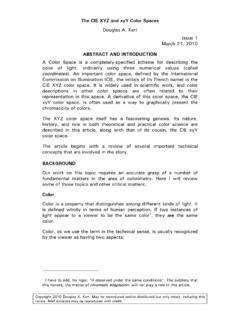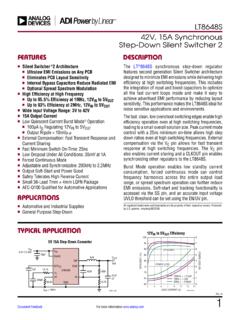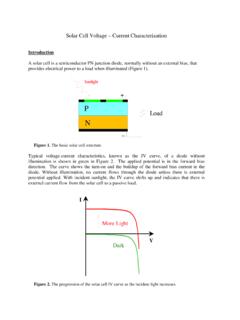Transcription of DYNAMIC LIGHT SCATTERING
1 University of California San Diego DYNAMIC LIGHT SCATTERING . to determine the radius of small beads in Brownian motion in a solution. Author: Marta Sartor e-mail: Introduction: D ynamic LIGHT SCATTERING is also known as Photon Correlation Spectroscopy. This technique is one of the most popular methods used to determine the size of particles. Shining a monochromatic LIGHT beam, such as a laser, onto a solution with spherical particles in Brownian motion causes a Doppler Shift when the LIGHT hits the moving particle, changing the wavelength of the incoming LIGHT . This change is related to the size of the particle.
2 It is possible to compute the sphere size distribution and give a description of the particle's motion in the medium, measuring the diffusion coefficient of the particle and using the autocorrelation function. This method has several advantages: first of all the experiment duration is short and it is almost all automatized so that for routine measurements an extensive experience is not required. Moreover, this method has modest development costs. Commercial "particle sizing" systems mostly operate at only one angle (90 ) and use red LIGHT (675 nm). Usually in these systems the dependence on concentration is neglected.
3 using more sophisticated experimental equipment (projector, short- wavelength LIGHT source), the methods can be not only considerably extended, but also more complicated and expensive. Although DYNAMIC SCATTERING is, in principle, capable of distinguishing whether a protein is a monomer or dimer, it is much less accurate for distinguishing small oligomers than is classical LIGHT SCATTERING or sedimentation velocity. The advantage of using DYNAMIC SCATTERING is the possibility to analyze samples containing broad distributions of species of widely differing molecular masses ( a native protein and various sizes of aggregates), and to detect very small amounts of the higher mass species (< in many cases).
4 Furthermore, one does not have to worry that protein aggregates are being lost within a -2- chromatographic column (a common problem in using SEC to characterize aggregates), because there is no chromatographic separation involved. Moreover, with this technique it is also possible to obtain absolute measurements of several parameters of interest, like molecular weight, radius of gyration, Translational diffusion constant and so on. However, the analysis might be difficult for non-rigid macromolecules. Another limit is that above the zero degree Kelvin molecules fluctuate ( molecules deviate from their average position).
5 The LIGHT SCATTERING : A ccording to the semi-classical LIGHT SCATTERING theory [Berne and Pecora, " DYNAMIC LIGHT SCATTERING " John Wiley, 1975], when LIGHT impinges on matter, the electric field of the LIGHT induces an oscillating polarization of electrons in the molecules. Hence the molecules provide a secondary source of LIGHT and subsequently scatter LIGHT . The frequency shifts, the angular distribution, the polarization, and the intensity of the scatter LIGHT are determined by the size, shape and molecular interactions in the SCATTERING material. Thanks to this is possible, with the aid of electrodynamics and theory of time dependent statistical mechanics, to get information about the structure and molecular dynamics of the SCATTERING medium trough the LIGHT SCATTERING characteristics of the system.
6 Different methods can be used to study the dynamics of a system with particles in Brownian motion, depending on the time scale of the molecular fluctuations. These methods are shown in the following figure [Berne and Pecora]. -3- A monochromator or filter (interferometer or diffraction grating) is placed in front of photomultiplier (direction 1) and it is used when the time scale of the fluctuations is above the microsecond (frequency above 1 MHz). The average DC. output of the photomultiplier is proportional to the spectral density of the scattered LIGHT at the filter frequency. The filter is then swept through a range of frequencies.
7 For processes faster than a picosecond (f > 10 GHz), diffraction gratings are used as filter, and for slow fluctuations between picosecond and microsecond, Fabry- Perot interferometers are used. Optical mixing techniques are used when the fluctuations are slower than microsecond (f < 1 MHz). The theory behind: T he experiment's theory is based essentially on two assumptions. The first condition is that the particles are in Brownian motion (also called random walk');. in this situation we know the probability density function, given by the formula: -4- (1) P(r,t|0,0)=(4 Dt)-3/2 exp (- r 2 4Dt ).
8 Where D is the diffusion constant. The second assumption is that the beads used in the experiment, are spherical particles with a diameter small compared to the molecular dimensions. If it is so, then it is possible to apply the Stoke-Einstein relation and hence have a formula that easily gives the diffusion constant: (2) D=k BT/6 a where a is the radius of the beads, kB is the Boltzmann constant, T is the temperature in Kelvin degrees (in this experiment it will be considered as if it is taking place at room temperature) and is the viscosity of the solvent. Since from the LIGHT SCATTERING is possible to obtain information about the position of the particles, thought the formulas above is easy to get the radius of the beads.
9 Set up: T he set up is illustrated here after. As it is possible to see from the illustration, the laser passes through a collimator lens and then hits the cell with the solution. The LIGHT is scattered and detected by a photomultiplier that transform a variation of intensity into a variation of voltage. LASER CELL. PHOTOMUL. TIPLIER. -5- As illustrated in the figure above, there is another collimating lens before the photomultiplier. The use of both the collimating lenses is essential in this experiment: the first lens allows us to focus the beam into the cell, so that the area that we will hit is far enough from the side of the cell.
10 The second lens is used to get an amount of scattered LIGHT that is neither too much nor insufficient. The photomultiplier is positioned at a SCATTERING angle of 90 degrees; indeed for this SCATTERING angle it is possible to neglect the nonlinearity of the linewidth with the SCATTERING angle. This is because at this angle / < After the photomultiplier, the signal is immediately preamplified and then sent to the computer where the voltage is elaborate through a program in Labview. Calibration: T he process of calibration is really delicate. The first operation is to check if the laser beam is at the same high in its entire path, then the focus the first lens in the middle of the cell and the second lens into the photomultiplier.

















